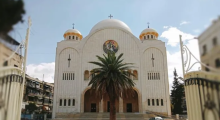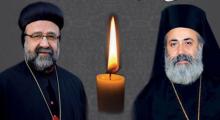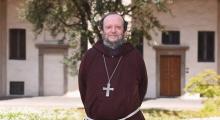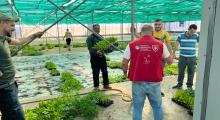Issued by the Catholic Center for Studies and Media - Jordan. Editor-in-chief Fr. Rif'at Bader - موقع أبونا abouna.org
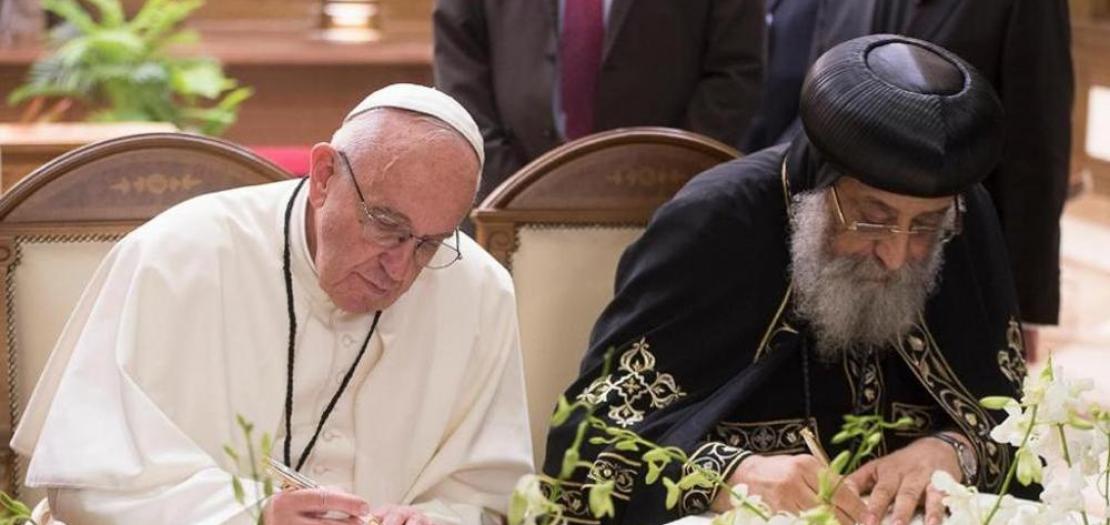
With their Joint Declaration (signed in Cairo), the Bishop of Rome and the Orthodox Coptic Patriarch archive the practice of “re-baptizing” contrary to the Gospel and obstacle to the ecumenical journey. A concrete step in the pilgrimage towards the full sacramental communion between Catholics and Orthodox Copts. The priest Gabriel Quicke: “It is a gift from the prayers of the new martyrs”.
Pope Francis often repeats that “baptism is enough” to proclaim the Gospel of Christ. The rediscovery of the shared gift of baptism is the starting point for walking towards the full sacramental unity of Christians. In the joint declaration signed in Cairo, Pope Francis and the Orthodox Patriarch, Tawadros II stated that they “will seek sincerely not to repeat the baptism that has been administered in either of our Churches for any person who wishes to join the other.” When the spotlight on Pope Francis’ trip to Egypt will turn off and the curtain of prefabricated titles will be lowered, these few words will remain a concrete step of primary consistency in the pilgrimage towards the full sacramental communion between Catholics and Orthodox. They are beginning to bury in the past the practice of “re-baptism” still administered today by some Christian communities to new faithful coming from other ecclesial confessions. A practice that represents an open wound in relations between the Churches and contradicts the authenticity of good ecumenical purposes. How can a true and full unity of Christians be, if Christians, who have already been baptized in the name of Christ are baptized once again as if they were pagans?
A reactive and “modern” practice
The practice of “re-baptize”, currently practiced by some of the Churches in the East, does not root in the liturgical practice of the great Fathers of the Church’s era, who were generally open to recognize the validity of the sacraments of Christians belonging to different confessions. In the modern age, as early as the 17th century, the action of both Catholic and Protestants missionaries in the East had re-established the confessional competition. Many East Churches, by reaction, stiffened their practice of recognizing the sacraments of other Christian denominations, and began practicing the “second baptism” of the new faithful who came from those Churches and ecclesial communities. In the past, the same practice was in many cases also applied to ecclesial and missionary realities that came from the West who collected proselytes coming from the native churches.
Especially since the nineties of the last century, in the Orthodox Coptic Church, the rise of so-called “mixed marriages” among Christians of different confessions played a key role in intensifying the practice of “re-baptism”. A practiced said to be linked to the doctrinal footprint of Patriarch Shenuda III, a charismatic and complex figure who remained at the helm of the Coptic Patriarchate from 1971 to 2012. Researcher Nikos Kouremenos, a researcher at Hebrew University of Jerusalem, quoted - Shenuda demanded in his writings and in his speeches to “re-baptize” Christians who showed interest in being in communion with the Coptic Church.”
A rigorous position that not all followed. Kouremenos continues, “Monks like Matta el Meskin, who since 1960 lived the so-called” rebirth “of Coptic monasticism, belonged to a group of Coptic prelates who did not share Shenuda’s rigid positions and thus recognized the sacramental validity of other Churches, founded on common faith and common baptism in Christ. The current Patriarch Tawadros is part of this theological tradition since the beginning of his Patriarchy.”
Among the leaders of the Christian Churches, Tawadros is considered a far-sighted pastor who is loved by the people. Another reason why he proceeds smoothly, as he needs to take in consideration the group of bishops in accordance with the rigorous positions of Shenuda, headed by Anba Bishoy, the metropolitan bishop of Damietta.
The elective affinities between Tawadros and Bergoglio
The Bishop of Rome and the Orthodox Coptic Patriarch pray every night for each other. They promised it in their first encounter, when Tawadros came to visit in May 2013 the Argentine bishop who had just became Pope for less than two months. On that occasion, the Coptic Patriarch had already shown his intent of wanting to put aside the practice of the “second baptism”. But it was necessary to proceed with caution, without forcing it on those bishops who decisively and devotedly defend Shenuda’s memory.
What happened in recent years has perhaps accentuated the elective affinities between Pope Francis and Pope Tawadros. The facts of martyrdom that struck the Coptic Church, and the Christian way with which the Coptic people lived these dramatic events- without recriminations, they certainly wept for their martyrs, but also celebrated their embrace with Christ in Paradise - have inspired Pope Francis’s constant hints to the “ecumenism of blood” and persecution.
After the massacres in the two Coptic churches on Palm Sunday, Pope Francis sent a Vatican delegation to Pope Tawadros “for him to physically” receive his condolences and his brotherly hug. In the papal delegation were, Cardinal Kurt Koch, Father Gabriel Quicke, and Copt Catholic priest Yoannis Lahzi Gaid, the Pope’s personal secretary. As Father Quicke, the Belgian priest, who is enthusiast of St. Augustine and is responsible for the relations with the Coptic and other Eastern Orthodox Churches at the Pontifical Council for the Unity of Christians, said, “They are two shepherds who share an intense spiritual syntony, because they are moved by the same Spirit and share the same outlook.”
A “dynamic” statement
The Joint Declaration signed in Cairo carries the imprint of the Sensus Ecclesiae shared by Pope Francis and Pope Tawadros. It expresses the perception of the life of the Church as a journey, a pilgrimage following together Christ in history. The passage of the practice of “rebaptism” was not expressed in terms of a legal provision dropped from above, or as a mechanical change of ecclesiastical politics, but as a desire that orientates choices (”will try not to repeat”), pursued to “delight” the heart of Christ, and entrusted to the patient work of His grace. Taking into account the resistances that Tawadros might find in some areas of Coptic clergy, “Perhaps,” Quicke said, “it will take some time for the practice of “re-baptizing” Christians to extinct everywhere. There might be local objections. But Pope Francis and Pope Tawadros have always taken note of the need to proceed with patience, even waiting for those who are slower. This is the Church on the way, which grows not by proselytizing but by attractiveness of grace, as Pope Ratzinger said. “
The way is indicated by the Gospel and the First Councils, as everyone both in the East and in the West recites the Nichea-Constantinople Creed, and professes “one baptism for the remission of sins.” The acknowledgment of sharing the same baptism, expressed as a sincere desire for the Common Declaration, to be carried out patiently along the path, gives the text a “dynamic” flair: “At Vatican Council II - Father Gabriel Quicke notes - we reaffirmed the common baptism as a starting point for the path to the restoration of the full unity of Christians. In the Joint Declaration of Pope Tawadros and Pope Francis, we describe the bond that brings us together in the same baptism as the basis of the pilgrimage we are doing “towards the blessed day in which we will finally gather together at the same Eucharistic table.” And I believe that the new steps towards full communion between Catholics and Orthodox Coptics are a gift that comes from the prayer of the new martyrs. They now repeat for us the prayer that Christ addressed to the Father, asking for the unity of his all: “that all of them may be one, Father, just as you are in me and I am in you. May they also be in us so that the world may believe that you have sent me”


